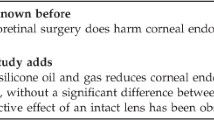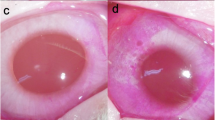Abstract
Purpose: To evaluate long term effects of perfluorophenanthrene (C12F24), a perfluorocarbon fluid, in the anterior chamber of the human eye, where residual perfluorophenanthrene was retained in the eye postoperatively. Methods: Slit-lamp microscopic and specular microscopic examinations of 4 eyes of 4 patients were performed. All the eyes were operated for complicated retinal detachment and they were aphakic at the end of the operations. Mean follow-up period was 10 months (6–16 months). Results: Perfluorophenanthrene was seen in the anterior chamber in the first or second day postoperatively as a single drop. In the third week, postoperatively, the first signs of splitting the perfluorophenanthrene (fish egging phenomena) was observed. There was no sign of corneal or anterior segment toxicity with the slit lamp microscopic examinations and the intraocular pressure was within normal limits during the follow-up period in all eyes. However, some structural changes of the corneal endothelium were shown by specular microscopy. Decreased endothelial cell density, are versed illumination pattern in which the normally dark cellular boundaries appear bright and intracytoplasmic light reflecting bodies were signs of cellular damage at the contact sites whereas no significant changes were seen at non contact sites. Conclusion: Residual perfluorophenanthrene in the anterior chamber does not induce gross corneal damageor ocular inflammation, although structural changes indicating the damage of the corneal endothelium, can be shown by specular microscopy at the contact sites. Corneal endothelial changes seem to arise from acontact-dependent effect of the perfluorophenanthrene.
Similar content being viewed by others
References
Haidt SJ, Clark LC Jr, Ginsberg J. Liquid perfluorocarbon replacement of the eye. Invest Ophthalmol Vis Sci 1982; 22(suppl): 233.
Chang S. Low viscosity liquid fluorochemicals in vitreous surgery. Am J Ophthalmol 1987; 103: 38–43.
Chang S, Özmert E, Zimmerman NJ. Intraoperative perflurocarbon liquids in the management of proliferative vitreoretinopathy. Am J Ophthalmol 1988; 106: 668–674.
Chang S, Lincoff H, Zimmerman NJ, Fuchs W. Giant retinal tears: surgical techniques and results using perfluorocarbon liquids. Arch Ophthalmol 1989; 107: 761–766.
Chang S, Reppucci V, Zimmerman NJ, Heinemann MH, Coleman DJ. Perfluorocarbon liquids in the management of traumatic retinal detachments. Ophthalmology 1989; 96: 785–792.
Moreira H, de Querioz JM, Liggett PE, McDonnell PJ. Corneal toxicity study of two perfluorocarbon liquids in rabbit eyes. Cornea 1992;11: 376–379.
Hyndiuk R, Murray TG, Palmer M, et al. Perfluoro−n−octane: evaluation of anterior segment toxicity associated with intraocular use. Invest Ophthalmol Vis Sci 1991; 32(suppl): 880.
Han DP, Nanda SK, O’Brien WJ, Guy J, Murray TG, Boldt C. Evaluation of anterior segment tolerance to short−term intravitreal perfluoron. Retina 1994; 14: 219–224.
Stolba U, Krepler K, Pflug R, et al. Experimental vitreous and aqueous replacement with perfluorophenanthrene. Retina 1997; 17: 146–153.
Glaser BM. Treatment of giant retinal tears combined with proliferative vitreoretinopathy. Ophthalmology 1986; 93: 1193–1197.
Peyman GA, Rednam KRV, Seetner AA. Retinal microincarceration with penetrating diathermy in the management of giant retinal tears. Arch Ophthalmol 1984; 102: 562–565.
Chang S, Zimmerman NJ, Iwamoto T, et al. Experimental vitreous replacement with perfluorotributylamine. Am J Ophthalmol 1987; 103: 29–37.
Nabih M, Peyman GA, Clark LJ Jr, et al. Experimental evaluation of perfluorophenanthrene as a high specific gravity vitreous substitute: a preliminary report. Ophthalmic Surg 1989; 20: 286–293.
Green K, Cheeks L, Friedman JM. Perfluorocarbon liquid effects on corneal endothelial permeability. Lens Eye Toxicity Res 1992; 11: 376–379.
Karel I, Filipec M, Obenberger J. Specular microscopy of the corneal endothelium after liquid silicone injection into the vitreous in complicated retinal detachments. Graefe’s Arch Clin Exp Ophthalmol 1986; 224: 195–200.
Karel I, Filipec M, Vrabec F, Obenberger J. The effect of liquid silicone on the corneal endothelium in rabbits. Graefe’s Arch Clin Exp Ophthalmol 1986; 224: 481–485.
Weinberger D, Goldenberg−Cohen N, Axer−Siegel R, Gaton DD, Yassur Y. Long−term follow−up of perfluorocarbon liquid in the anterior chamber. Retina 1998; 18: 233–223
Author information
Authors and Affiliations
Rights and permissions
About this article
Cite this article
Gurelik, G., Akata, F., Bilgihan, K. et al. Effects of perfluorophenanthrene on the human corneal endothelium. Int Ophthalmol 22, 377–383 (1998). https://doi.org/10.1023/A:1006452923513
Issue Date:
DOI: https://doi.org/10.1023/A:1006452923513




